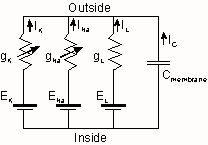Hodgkin-Huxley model of squid axon
This program runs the Hodgkin-Huxley model of the squid giant axon in "current
clamp" mode. Use it to see the voltage responses of the axon membrane to
electrical currents.
About this model
In the late 1940's and early 1950's, Alan Hodgkin and Andrew Huxley used
the newly-invented voltage clamp to investigate the ionic mechanism of
the action potential. They found that the depolarizing phase of the action
potential, or upstroke, is due to activation of sodium channels in the
axonal membrane. Inward sodium ion flux tends to depolarize the axon.
The repolarizing phase, or downstroke, is due both to inactivation of sodium
channels and activation of potassium channels. Reduced inward sodium flux
coupled with outward flux of potassium ions causes repolarization.
They found that both sodium and potassium channels
are activated, or gated, by voltage. Both are activated by depolarization
of the axonal membrane. They were unable to study ion channel function
at the single channel level, so they constructed a mathematical model of
the ionic currents based on total ionic currents. The model can be described
like an electric circuit with variable resistors representing the voltage-sensitive
sodium and potassium conductances, a fixed capacitor representing the cell
membrane, a fixed resistor representing a leakage conductance, and batteries
representing the ionic potentials. 
In their model, sodium and potassium channel opening
is determined by gates in the channel. The complexity of the model as a
whole is due to the complexity of the gating process, which determines
the way in which the variable resistors in the circuit model operate. Sodium
channels have two gates: one for activation and one for inactivation. Activation
is proportional to the third power of a gating factor m, and inactivation
is proportional to a gating factor h. Total sodium current is proportional
to m3h, the fraction of the channels active. Potassium channels
are hypothesized to have only one gate, and total potassium current is
proportional to n4. These gating factors operate as a function
of voltage and time.
Their voltage-clamp analysis satisfactorily predicted
many of the features of the action potential in axons, including: the form,
duration and amplitude of the spike; refractory period; subthreshold phenomena;
and anode-break excitation.
Parameters:
This program will allow you to control all of the parameters in the Hodgkin-Huxley
model of the squid axon.
-
Integration parameters
-
step size
-
number of steps (number of data points)
-
step size for integration (Runge-Kutta method)
-
Stimulus current parameters
-
stimulus current amplitude
-
time at beginning of stimulus
-
stimulus duration
-
repetitive stimulation
-
stimulus rate
-
Axon parameters
-
initial membrane potential
-
resting membrane potential
-
specific membrane capacitance
-
Q10 for rate constants
-
temperature
-
maximal sodium conductance
-
sodium ion reversal potential
-
maximal potassium conductance
-
potassium ion reversal potential
-
leak conductance
-
leak current reversal potential
-
resting value of variable n
-
resting value of variable m
-
resting value of variable h
-
and the value of their rate equation constants
Back to neural models page
